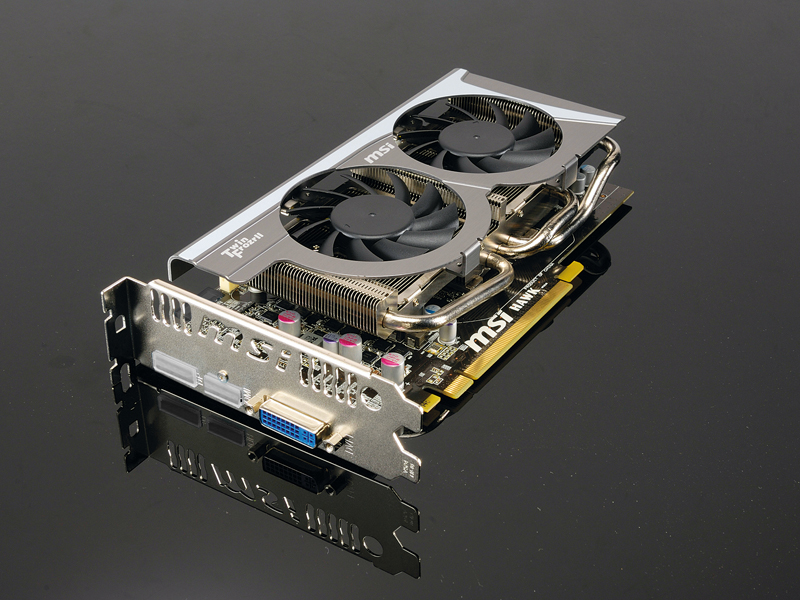TechRadar Verdict
Pros
- +
800 stream shaders
- +
DX11 support
- +
AMD's latest tech
- +
Factory overclocked
- +
Great performance in today's games
Cons
- -
128-bit memory bus
- -
Not much spare performance
- -
Doubts over AMD's tessellator
Why you can trust TechRadar
There are two ways of looking at the MSI 5770 Hawk. On the one hand, it's great value compared to the aging generation of DX10 cards. After all, thanks to the AMD Radeon HD 5770 graphics chipset, you get 800 stream shaders, 40 texture units and 16 render outputs.
Those figures are all a match for the old Radeon HD 4800 series, until late last year AMD's flagship offering. This factory overclocked MSI board also packs a Radeon HD 4890-spanking core clockspeed of 875MHz. For £124, it's a steal.
In fact, it almost looks too good to be true. Surely something had to give when AMD cooked up this cut-price graphics chipset? Turns out, it's the memory bus that's taken a hit, cleaved asunder and reduced to just 128 bits in width. It's been an awfully long time since a 128-bit bus was fit for the job of serious gaming. In that context, the other way of looking at the 5770 Hawk is as a minor tragedy in the making.
AMD and MSI, of course, would argue that the use of ultra-fast 4.8Gbps GDDR5 memory makes up for the narrow bus width. For sure, it does lift bandwidth significantly. But there's no arguing with the benchmark results. The bus does hurt performance. Compared to XFX's Radeon HD 4890, the Hawk is slower across the board. Don't forget, the 4890 is an old school DX10 GPU with the same number of shaders and render outputs as well as similar clockspeeds.
That said, the hobbled memory bus doesn't stop the 5770 Hawk from pummelling its closest competition, the Gigabyte GeForce GTS 250. Even at the sort of ultra-high detail and resolution settings that generate massive bandwidth demands, the 5770 has the measure of the 250.
Moreover, if you exclude the likes of Crysis: Warhead, which in truth is a freakishly demanding game in terms of graphics power, the Hawk has what it takes to run almost anything at full-HD resolutions and with most of the eye candy enabled. Anti-aliasing at 1,920 x 1,080 isn't out of the question either. That's impressive for a mid-range card.
We liked
On paper, the Hawk promises the rendering power of AMD's last-generation flagship graphics chipset at a fraction of a price. In practice, it comes awfully close to delivering fully. By any metric it's a powerful 3D card.
Even better, it's a pukka DirectX 11 board. That means you get full support for the latest features in Microsoft's all-important multimedia API. That includes the intriguing tessellator, which could lead to massively increased geometric detail in future games.
Then there's the Compute Shader. If anything is going to bring general purpose processing on graphics chips into the mainstream, it's a common platform provided by Microsoft. If that does happen, the 5770 has it covered.
We disliked
You could argue that what really matters is not what this card might have been but simply whether it delivers a great gaming experience. But the knowledge of just how good it could have been with a wider 256-bit memory bus is incredibly frustrating.
It may be the only significant flaw, but it's a biggie. In truth, it doesn't prevent the Hawk from delivering smooth performance in the vast majority of today's games. But it does leave it with very little in hand when more demanding titles appear in future. As with all Radeon HD 5000 series cards, we also have our doubts over the efficacy of AMD's take on the DX11 hardware tessellator.
Verdict
Forgive us for not changing the record, but there's a damn fine mid-range GPU here and it's desperate to escape the shackles of a cheapo 128-bit bus. With a 256-bit bus, the MSI 5770 Hawk would genuinely be in content for top honours as the most cost effective performance graphics board on the planet. Instead, it's merely a very good card and a missed opportunity.
Follow TechRadar Reviews on Twitter: http://twitter.com/techradarreview
Technology and cars. Increasingly the twain shall meet. Which is handy, because Jeremy (Twitter) is addicted to both. Long-time tech journalist, former editor of iCar magazine and incumbent car guru for T3 magazine, Jeremy reckons in-car technology is about to go thermonuclear. No, not exploding cars. That would be silly. And dangerous. But rather an explosive period of unprecedented innovation. Enjoy the ride.
